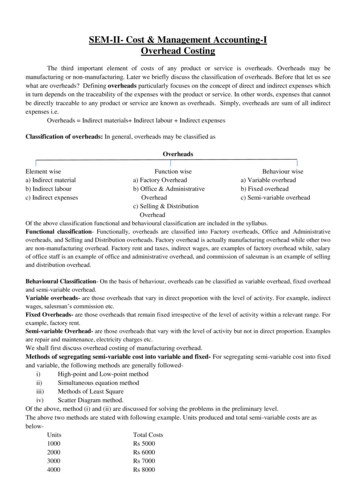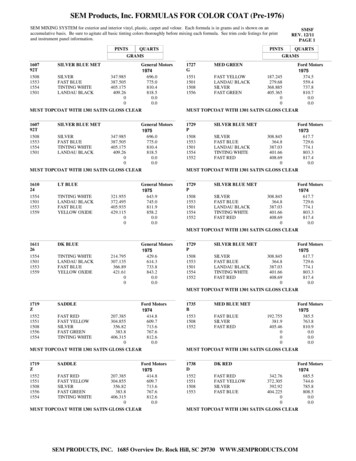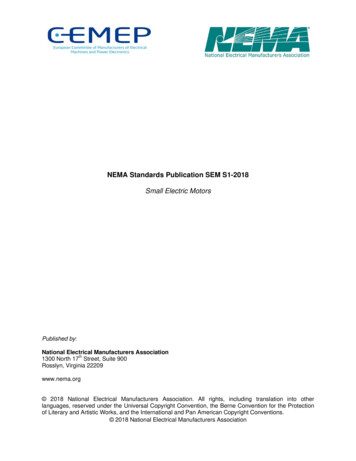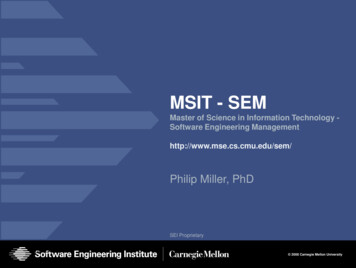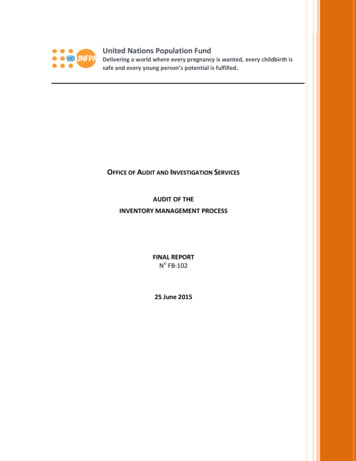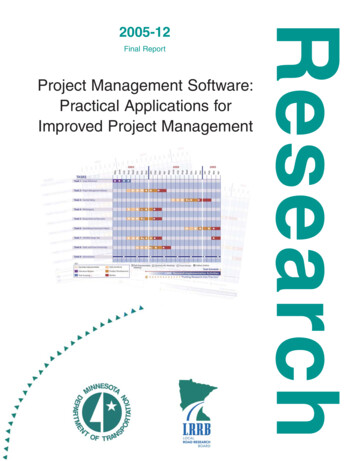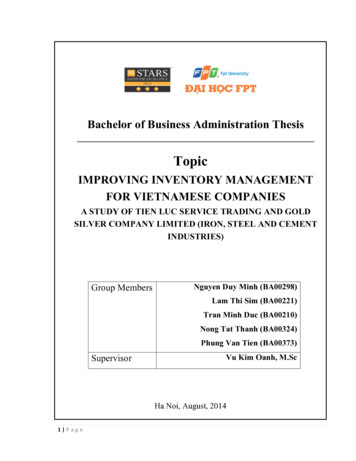
Transcription
FINANCIAL MANAGEMENTwww.eiilmuniversity.ac.in
Subject: FINANCIAL MANAGEMENTCredits: 4SYLLABUSOverviewIntroduction to Financial Management: Objectives of Financial Management, Functions of FinancialManagement; Financial Instruments: Equity Shares, Preference Shares, Right Issues; Debts: Debentures, Typesof Debentures; Indian Financial System: Functions of Financial Market, Classification of Financial Markets,Efficiency of Financial System, Skeleton of the Financial System; Time Value of Money; Valuation of Bondsand Shares.Financial StatementsComparative Statement: Importance of Financial Statement, Limitations, Constructing Comparative Statement;Common Size Statement: Advantages of Common Size Statement, Limitations of Common Size Statement,Constructing Common Size Statement; Trend Analysis: Advantages of Trend Percentages Analysis, Limitationsof Trend Percentages Analysis, Method of Preparation of Trend Percentages, Precautions; Ratio Analysis:Importance, Limitations and Classification of Ratios.Cash FlowFund Flow Statement: Objectives of Funds Flow Statement, Limitations, Preparation of Funds Flow Statement;Cash Flow Statement: Direct and Indirect Methods of Cash Flow.Fixed Capital AnalysisCapital Budgeting: Features of Capital Budgeting, Importance of Capital Budgeting; Evaluations Techniques ofProjects: Traditional Techniques: Pay Back Period, ARR,Time Adjusted Techniques: NPV, IRR, PI; Risk andUncertainty in Capital Budgeting.Capital Structure and Dividend PolicyLeverage Analysis: Operating Leverage, Financial Leverage, Combined Leverage; Capital Structure: FactorsDetermining the Capital structure, Theories of Capital Structure; Cost of Capital: Significance of Cost ofCapital, Computation of Cost of Capital, EPS, EBIT Analysis; Dividend Policy: Dividend decision andvaluation of Firm, Determinants of Dividend Policy, Types of Dividends, Forms of Dividend, Bonus Issue.Working Capital AnalysisWorking Capital: Operating Cycle/Working Capital Cycle, Factors Effecting Working Capital, Importance ofAdequate Working Capital, Financing of Working Capital, Determining Working Capital Financing Mix,Working Capital Analysis, Estimation of Working Capital Requirements; Receivables Management: Costs ofMaintaining Receivables, Meaning and Definition of Receivables Management , Dimensions of ReceivablesManagement.Inventory ManagementInventory Management: Meaning of Inventory, Purpose of Holding Inventory, Inventory Management,Objectives of Inventory Management; Inventory Management Techniques.Cash Management AnalysisCash Management: Motives for Holding Cash, Cash Management, Managing Cash Flows; Cash ManagementModels.
Foreign Exchange OrientationInternational Finance: Exchange Rate, Arbitrage Process as a Means of Attaining Equilibrium On Spot Markets,Arbitrage in Forward Market; Managing of Foreign Exchange Risk: Foreign Exchange Risk Management,Management of Economic exposure, Management of Operating Exposure; Raising Foreign Currency Finance.Suggested Reading:1. Financial Management: Text and Problems by M Y Khan & P K Jain, Publisher: TMH, New Delhi.2. Financial Management Theory & Practice by Prasanna Chandra, Publisher: TMH, New Delhi.3. Financial Management by I M Pandey, Publisher: Vikas Publishing House, New Delhi.4. Fundamentals of Financial Management by Van Horne, Publisher: Prentice Hall of India.5. Advanced Accounting by Gupta R.L. and Radha Swamy M., Publisher: Sultan Chand & Sons, New Delhi.6. Financial Management by Kishore R., Publisher: Taxman’s Publishing House, New Delhi.
e1.1 Introduction to Financial Management1.1.1 Objectives of Financial Management1.1.2 Functions of Financial Management1.2 Financial Instruments: Equity Shares, Preference Shares; Right Issue1.3 Debts: Debentures, Types of Debentures1.4 Indian Financial System1.4.1 Functions of Financial Markets1.4.2 Classification of Financial Markets1.4.3 Efficiency of Financial system1.4.4 Skeleton of the Financial System1.5 Time Value of Money1.6 Valuation of Bonds and Shares.1.7 Review --------------------------1.1 INTRODUCTION TO FINANCIAL --------------------------Finance is defined as the provision of money at the time when it is required. Every enterprise,whether big, medium, small, needs finance to carry on its operations and to achieve its target. Infact, finance is so indispensable today that it is rightly said to be the blood of an enterprise.Without adequate finance, no enterprise can possibly accomplish its objectives.Meaning of Financial Management: Financial management refers to that part of themanagement activity, which is concerned with the planning, & controlling of firm’s financialresources. It deals with finding out various sources for raising funds for the firm. Financialmanagement is practiced by many corporate firms and can be called Corporation finance orBusiness Finance.According to Guthmann and Dougall: “Business finance can be broadly defined as the activityconcerned with the planning, raising controlling and administrating the funds used in thebusiness.”According to Joseph & Massie: “Financial Management is the operational activity of abusiness that is responsible for obtaining and effectively utilizing the funds necessary forefficient operations”5
Financial Management is the application of the general management principles in the area offinancial decision-making, namely in the areas of investment of funds, financing variousactivities, and disposal of profits.Financial management is the art of planning; organizing, directing and controlling of theprocurement and utilization of the funds and safe disposal of profits to the end that individual,organizational and social objectives are accomplished.Financial managementIs concerned withFinancing decisionInvestment DecisionDividend DecisionAnalysisRisk and Return RelationshipTo achieve the goal ofProfitMaximizationWealthMaximizationFigure: 1.1 Financial Management Interrelationships1.1.1 Functions of Financial ManagementA financial manager has to concentrate on the following areas of the finance function.1. Estimating Financial Requirements: The first task of the financial manager is toestimate short term and long-term financial requirement of his business. For this purpose,he will prepare a financial plan for present as well as future. The amount required forpurchasing fixed assets as well as the needs of funds for working capital has to be6
ascertained. The estimation should be based on the sound financial principles so thatneither there are inadequate or excess funds with the concern. The inadequacy will affectthe working of the concern and excess funds may tempt a management to indulge inextravagant spending.2. Deciding Capital Structure: The capital structure refers to the kind and proportion ofthe different securities for raising funds. After deciding about the quantum of fundsrequired it should be decided which type of security should be raised. It may be wise tofinance fixed securities through long term debts. Long-term funds should be employed tofinance working capital also. Decision about various sources of funds should be linked tocost of raising funds. If cost of rising funds is high, then such sources may not be useful.A decision about the kind of the securities to be employed and the proportion in whichthese should be used is an important decision which influences the short term and thelong term planning of the enterprise.3. Selecting a Source of Finance: After preparing a capital structure, an appropriate sourceof finance is selected. Various sources from which finance may be raised, includes sharecapital, debentures, financial deposits etc. If finance is needed for short periods thenbanks, public’s deposits, financial institutions may be appropriate. If long-term finance isrequired the share capital, debentures may be useful.4. Selecting a Pattern of Investment: When fund have been procured then a decision aboutinvestment pattern is to be taken. The selection of investment pattern is related to the useof the funds. A decision has to be taken as to which assets are to be purchased? The fundwill have to be spent first. Fixed asset and the appropriate portion will be retained for theworking capital. The decision making techniques such as capital Budgeting, opportunitycost analysis may be applied in making decision about capital expenditures. Whilespending in various assets, the principles of safety, profitability, and liquidity should notbe ignored.5. Proper Cash Management: Cash management is an important task of financialmanager. He has to assess the various cash needs at different times and then makearrangements for arranging cash. Cash may be required to make payments to creditors,purchasing raw material, meet wage bills, and meet day to day expenses. The sources ofcash may be Cash sales, Collection of debts, Short-term arrangement with the banks. Thecash management should be such that neither there is shortage of it and nor it is idle. Anyshortage of cash will damage the creditworthiness of the enterprise. The idle cash withthe business mean that it is nit properly used. Through Cash Flow Statement one is ableto find out various sources and applications of cash.6. Implementing Financial Controls: An efficient system of financial managementnecessitates the use of various control devices. Financial control device generally usedare;a. Return Investmentb. Ratio analysis7
c. Break even analysisd. Cost controle. Cost and internal audit.7. The use of various control techniques: This will help the financial manager inevaluating the performance in various Areas and take corrective measures wheneverneeded.8. Proper use of Surpluses: The utilization of profits or surpluses as also an importantfactor in financial management. A judicious use of surpluses is essential for theexpansion and diversification plans and also protecting the interest of the shareholders.The ploughing back of profit is the best policy of further financing. A balance should bestruck in using the funds for paying dividends and retaining earnings for financingexpansion plans.1.1.2 Objectives of the Financial ManagementThe main objective f a business is tom maximize the owner’s economic welfare. Financialmanagement provides a framework for selecting a proper course of action and deciding acommercial strategy.The objectives can be achieved by: (i) Profit maximization (ii) Wealth maximizationProfit Maximization: Profit earning is the main aim of every economic activity. A businessbeing an economic institution must earn profit to cover its cists and provide funds for growth. Nobusiness ca survives without earning profit. Profit is a measure of efficiency of a businessenterprise. Profit also serves as a protection against risks which cannot be ensured.Arguments in favor of Profit Maximization1. When profit earning is the aim of the business then the profit maximization should be theobvious objective.2. Profitability is the barometer for measuring the efficiency and economic prosperity of abusiness enterprise, thus profit maximization is justified on the ground of the rationality.3. Profits are the main source of finance for the growth of the business. So a business shouldaim at maximization of the profits for enabling its growth and development.4. Profitability is essential for fulfilling the social goals also. A firm by pursuing theobjectives of profits maximization also maximizes the socio economic welfare.5. A business may be able to survive under unfavorable condition only if it had some pastearnings to rely upon.Arguments against of Profit Maximization1. It is precisely defined. It means different things for different people. The term ‘Profit’ isvague and it cannot be precisely defined. It means different things for different people.Should we mean (i) Short term profit or long term profit? (ii) Total profit or earning per8
share? (iii) Profit before tax or after tax? (iv) Operating profit or profit available for theshareholders?2. It ignores the time value of money and does not consider the magnitude and the timing ofearnings. It treats all the earnings as equal though they occur in different time periods. Itignores the fact that the cash received today is more important than the same amount ifcash received after, say, three years.3. It does not take into consideration the risk of the prospective earning stream. Someprojects are more risky than others. Two firms may have same expected earnings pershare, but if the earning stream in one is more risky the market share of its share will becomparatively less.4. The effect of the dividend policy on the market price of the shares is also not consideredin the objective of the profit maximization. In case, earnings per share is the onlyobjective then the enterprise may not think of paying dividends at all because it retainsprofits in the business or investing them in the market may satisfy this aim.Wealth Maximization: Financial theory asserts that the wealth maximization is the singlesubstitute for a stake holder’s utility. When the firm maximizes the shareholder’s wealth, theindividual stakeholders can use this wealth to maximize his individual utility. It means that bymaximizing stakeholder’s wealth the firm is operating consistently toward maximizingstakeholder’s utility. A stake solder’s wealth in the firm is the product of the numbers of theshares owned, multiplied within the current stock price per share.Stockholder’s current wealth in the firm (No. Of shares owned) * (Current stock priceper sh
Fundamentals of Financial Management by Van Horne, Publisher: Prentice Hall of India. 5. Advanced Accounting by Gupta R.L. and Radha Swamy M., Publisher: Sultan Chand & Sons, New Delhi. 6. Financial Management by Kishore R., Publisher: Taxman’s Publishing House, New Delhi. 5 ----- OVERVIEW ----- Structure 1.1 Introduction to Financial Management 1.1.1 Objectives of Financial

